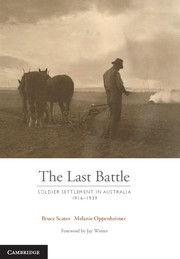Book contents
- Frontmatter
- Dedication
- Frontispiece
- Foreword
- Contents
- Note to readers
- Images
- Acknowledgements
- Introduction ‘A Land Fit for Heroes’: Implementing soldier settlement in Australia
- PART 1 MANAGING THE MEN
- PART 2 BATTLING THE LAND
- PART 3 DAMAGED MEN
- PART 4 GETTING ON
- Notes
- Select bibliography
- Index
- Plate section
- References
Select bibliography
Published online by Cambridge University Press: 05 September 2016
- Frontmatter
- Dedication
- Frontispiece
- Foreword
- Contents
- Note to readers
- Images
- Acknowledgements
- Introduction ‘A Land Fit for Heroes’: Implementing soldier settlement in Australia
- PART 1 MANAGING THE MEN
- PART 2 BATTLING THE LAND
- PART 3 DAMAGED MEN
- PART 4 GETTING ON
- Notes
- Select bibliography
- Index
- Plate section
- References
- Type
- Chapter
- Information
- The Last BattleSoldier Settlement in Australia 1916–1939, pp. 282 - 286Publisher: Cambridge University PressPrint publication year: 2016



